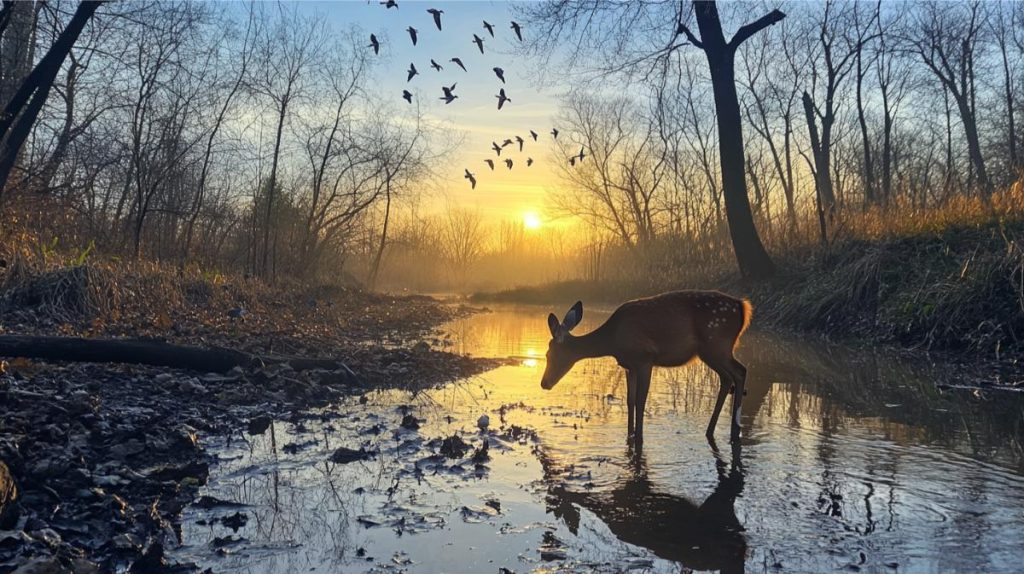Picture a world where animals roam freely in their natural homes. This isn’t just a nice idea – it’s crucial for our planet’s health.
Protecting wildlife habitats helps keep entire ecosystems alive and thriving.
When you save one species’ home, you’re actually helping many others. Think of it like a domino effect, but in reverse. Instead of things falling apart, they start coming together.
Animals, plants, and even tiny organisms all play a part in keeping their environment balanced.
You might wonder why this matters to you. Well, healthy ecosystems clean our air, purify our water, and even help control our climate. Plus, they’re pretty awesome to look at!
By protecting animal habitats, you’re not just saving cute critters – you’re helping keep our whole planet running smoothly.
Key Takeaways
- Protecting one animal’s habitat benefits many species
- Healthy ecosystems provide essential services for humans
- Conservation efforts help maintain Earth’s natural balance
The Vital Role of Biodiversity

Biodiversity is the heart of our planet’s health. It keeps ecosystems strong and provides countless benefits to you and all living things.
Let’s dive into why biodiversity matters so much for our world.
From Genes to Ecosystems
Picture biodiversity as nature’s toolkit. It starts with genes – the building blocks of life.
Each species has its own unique genetic code, like a secret recipe. This genetic diversity helps creatures adapt to changes.
Species diversity is next. It’s like having a big group of friends with different skills.
Some plants make oxygen, while others filter water. Animals pollinate flowers or spread seeds.
At the top, we have ecosystem diversity. Think of it as Earth’s different neighborhoods. Forests, oceans, and deserts each play a special role.
Together, these levels of diversity make our planet resilient. They help life bounce back from challenges.
It’s like having a backup plan for every situation!
Nature’s Balancing Act

Biodiversity keeps nature in check, like a cosmic juggling act. Each species has its part to play in this grand performance.
Take bees, for example. These tiny performers don’t just make honey – they’re star pollinators! Without them, many plants would struggle to reproduce.
This would affect the animals that eat those plants, and so on.
Predators keep prey populations in check. Decomposers recycle nutrients. Plants clean the air and stabilize soil.
It’s a complex dance where everyone has their steps.
This balance provides vital ecosystem services. Clean air, fresh water, fertile soil – you benefit from these every day!
Nature’s balance even helps regulate the climate. Talk about a multi-talented cast!
Threats to the Web of Life
Sadly, biodiversity is under attack, and the villains are many.
Habitat loss is the big bad – as humans expand, nature shrinks. It’s like bulldozing neighborhoods in the animal kingdom.
Climate change is turning up the heat – literally. Some species can’t take the pressure and are forced to move or adapt quickly.
Pollution is another nasty character. It poisons habitats and messes with food chains.
Imagine trying to breathe through a straw – that’s what some marine animals deal with due to plastic pollution.
Overfishing and hunting throw ecosystems off balance. It’s like removing too many pieces from a Jenga tower – eventually, it all comes crashing down.
But don’t worry! Conservation efforts are fighting back. Protected areas, sustainable practices, and laws like the Endangered Species Act are helping. You can join this heroic quest too!
Conservation Strategies

Protecting animal habitats is crucial for saving ecosystems. Let’s look at some key strategies that can make a real difference.
Protected Areas and Legal Frameworks
You might wonder how we can shield vulnerable habitats from harm.
Protected areas are a great start! These special zones give animals a safe space to thrive. Think of them as VIP lounges for wildlife. Cool, right?
Legal frameworks also play a big role. Ever heard of CITES? It’s like a strict bouncer for endangered species trade.
These laws help keep rare critters safe from harm.
But it’s not just about drawing lines on a map. We need to make sure these areas are actually protected.
That means boots on the ground and eyes in the sky!
Community and Global Involvement
You know what they say – it takes a village to raise a child. Well, it takes the whole world to save an ecosystem!
Local communities are the real MVPs here. When people living near habitats get involved, magic happens. They become the guardians of their local wildlife.
But don’t forget about global efforts!
Organizations like the IUCN are like the Avengers of conservation. They bring together experts from all over to tackle big challenges.
You can get involved too! Whether it’s supporting a local wildlife group or joining a global campaign, every bit helps.
The Importance of Research and Education
Knowledge is power, especially when it comes to saving ecosystems. Research helps us understand what animals need to survive and thrive.
Scientists are like wildlife detectives. They study everything from migratory birds to keystone species. Their findings help us make smart decisions about habitat protection.
But research isn’t just for the lab coats. You can be a citizen scientist too! Many projects welcome volunteers to help collect data.
Education is equally important. The more people know about ecosystems, the more they care.
Schools, nature centers, and even social media can spread the word.
So next time you learn something cool about wildlife, share it! You never know who you might inspire to join the conservation cause.
